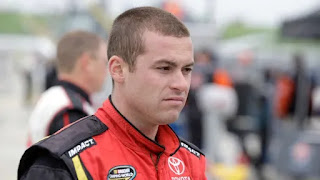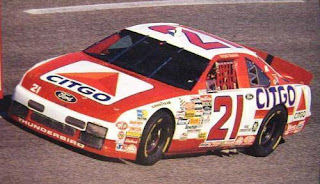NASCAR's Forgotten Dark History: Tales of Derailment, Drugs, and Destruction
NASCAR's Forgotten Dark History: Tales of Derailment, Drugs, and Destruction
By Brian H Cotnoir
If you asked most NASCAR fans to point out the Darkest Time in the Sports History, I'm sure many fans would say from between 2000-2001, when the sport lost five drivers---Adam Petty, Kenny Irwin Jr., Tony Roper, Dale Earnhardt Sr., and Blaise Alexander--all in racing accidents. The cause of death for all five was a basilar skull fracture. The following season ARCA driver, Eric Martin was killed when he was hit driver side door after spinning during a practice session at Charlotte Motor Speedway. These tragic events led a safety revolution in NASCAR which led to the development of NASCAR's fifth generation car (dubbed "The Car of Tomorrow"), mandatory head and neck restraints for all competitors, all race teams were required to have a Spotter for all Practice sessions, and the installation of steal of foam walls--known better as SAFER Barriers--to replace the solid concrete walls. However, it would take several years to have SAFER Barriers installed at all active NASCAR. It seemed like NASCAR's Darkest Days on the track were now behind them. However, off the track between 2003-2015 NASCAR saw a previous unprecedented use of illicit drugs in the sport. It led to the end of some careers and in a few tragic cases lives.
In 2002, Christian Elder was involved in a violent wreck during qualifying for the NASCAR Busch Series at the Chicagoland Speedway. At the time NASCAR had not begun to install SAFER Barriers at it's tracks and wouldn't begin to install them until the following season. Still, it wouldn't be until 2006 that all NASCAR tracks had SAFER Barriers installed. The wreck left Elder with a concussion and a broken collarbone; and would force him to retire from the sport. In 2007, Elder died of a drug overdose at the age of 38. It is believed he had been taking a mixture of pills to deal with the pain he was still enduring five years after the accident from his career ending wreck.
From 2005-2007 NASCAR drivers Shane Hmiel, Kevin Grubb, Aaron Fike, and Tyler Walker would be suspended indefinitely by NASCAR for "actions detrimental to the sport". At the time NASCAR did not have an official drug policy; drivers could be summoned by NASCAR to submit to a random drug test at any time or if there was "reasonable suspicion". Hmiel, the son of former NASCAR Crew Chief Steve Hmiel, would eventually be banned from NASCAR for life after failing a third drug test in 2005. Shane Hmiel completed drug rehab and attempted to start a new career in USAC, but unfortunately, he was involved in a single car wreck during qualifying at Terra Haute and suffered from permanent paralysis.
In 2004, NASCAR Busch Series driver Kein Grubb failed his first drug test, he was miss the next two seasons before returning for a part-time ride in 2006. Following a crash on lap 2 of a race at Richmond, Grubb was ordered by NASCAR to submit to a random drug test, Grubb refused and was once again suspended. Grubb claimed that he missed the drug test, because the accident at Richmond had left him concussed and had left him with no recollection of being told he needed to appear for a drug test. NASCAR suspended Grubb indefinitely for his actions. Kevin Grubb never made another start in NASCAR following his suspension. In 2009, he was found dead in a Virginia Motel of a self-inflicted gunshot wound. Kevin Grubb was 31 years old.
Sprint Car crossovers Tyler Walker and Aaron Fike had struggled to transition to stock cars. In 2007 Walker failed a drug test and was suspended by NASCAR. That same year Aaron Fike was busted outside an Ohio Amusement Park with heroin and was suspended by NASCAR. Fike lost his Truck Series ride with Red Horse Racing and has not raced NASCAR since. He did however, eventually complete NASCAR's Road to Recovery Program and was re-instated by the sport in 2012.
Shane Sieg, the older brother of NASCAR Xfinity drivers Ryan & Kyle Sieg, was also suspended in 2011 for violating NASCAR's Substance Abuse Policy. In 2017, Sieg was found dead four days before his 35th birthday. Although no official cause of death was ever stated by Sieg's family or NASCAR, it has been speculated by some that he died of an accidental drug overdose.
It's curious as to why so many NASCAR drivers turned to drugs during this time in the sport. Was it to cope with pain, or depression, or anxiety? We may never know why so many drivers chose turned to drugs during this time. since 2009 NASCAR has implemented it's "Road to Recovery" Program; Any driver in NASCAR who fails a drug test, must complete the Program before being re-instated by NASCAR. A.J. Allmendinger is probably the programs most successful story to come from the Road to Recovery Program as he's gone on to win 2 Cup Series races and several more in the NASCAR Xfinity Series.
It's unfortunate, but understandable, that so many drivers from this era have been forgotten. Unlike other major sports leagues, drivers, teams, and NASCAR require millions of dollars in corporate sponsorship to operate and be competitive. Any driver who was busted for drug use, obviously would be a huge turn off to most companies looking to sponsor a driver or team. NASCAR has come a long way with its drug testing policy for its drivers and crew members, but it's still a shame that several drivers had to hit bottom or lose their lives before they began doing something to help prevent it.








Comments
Post a Comment